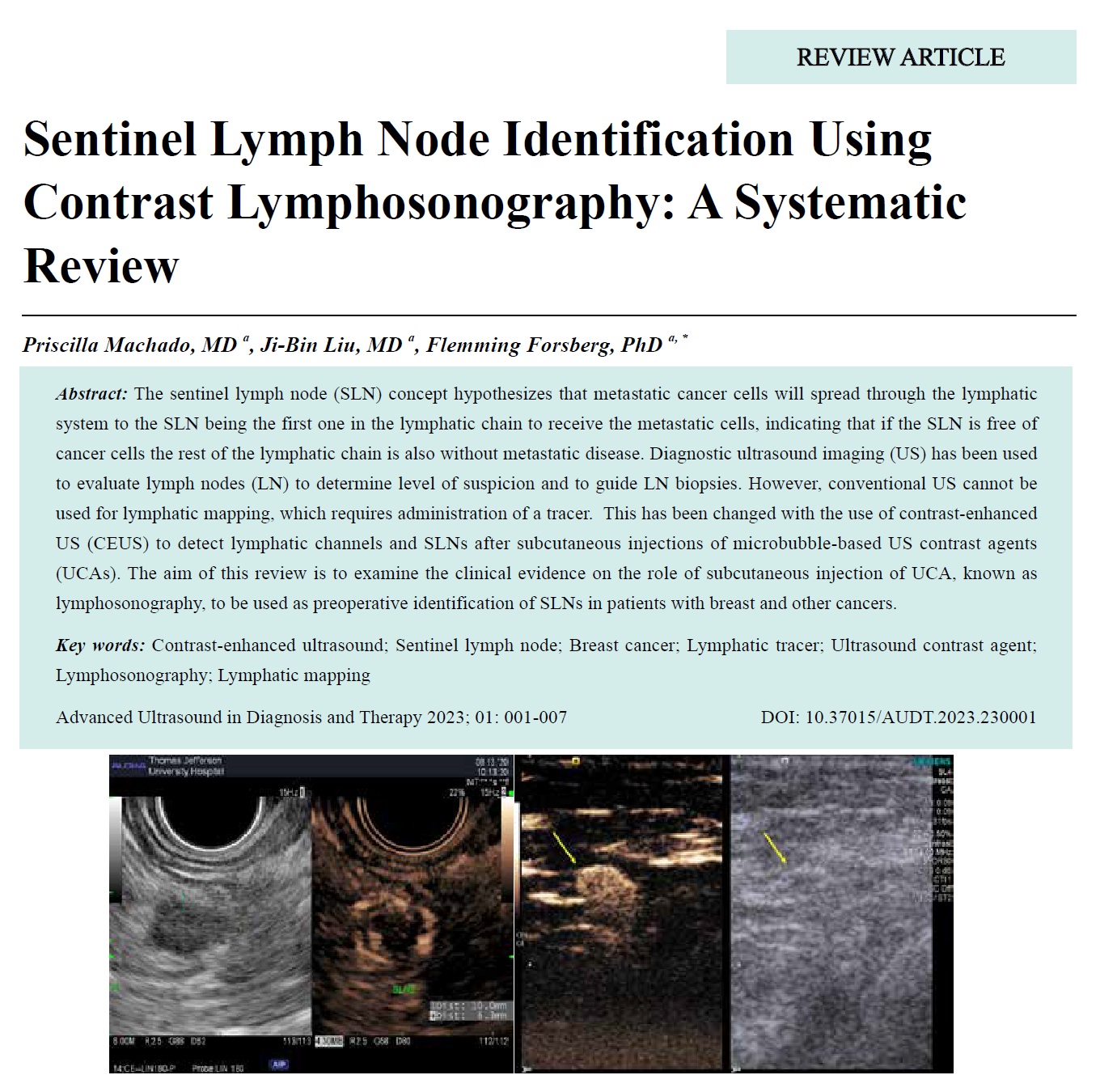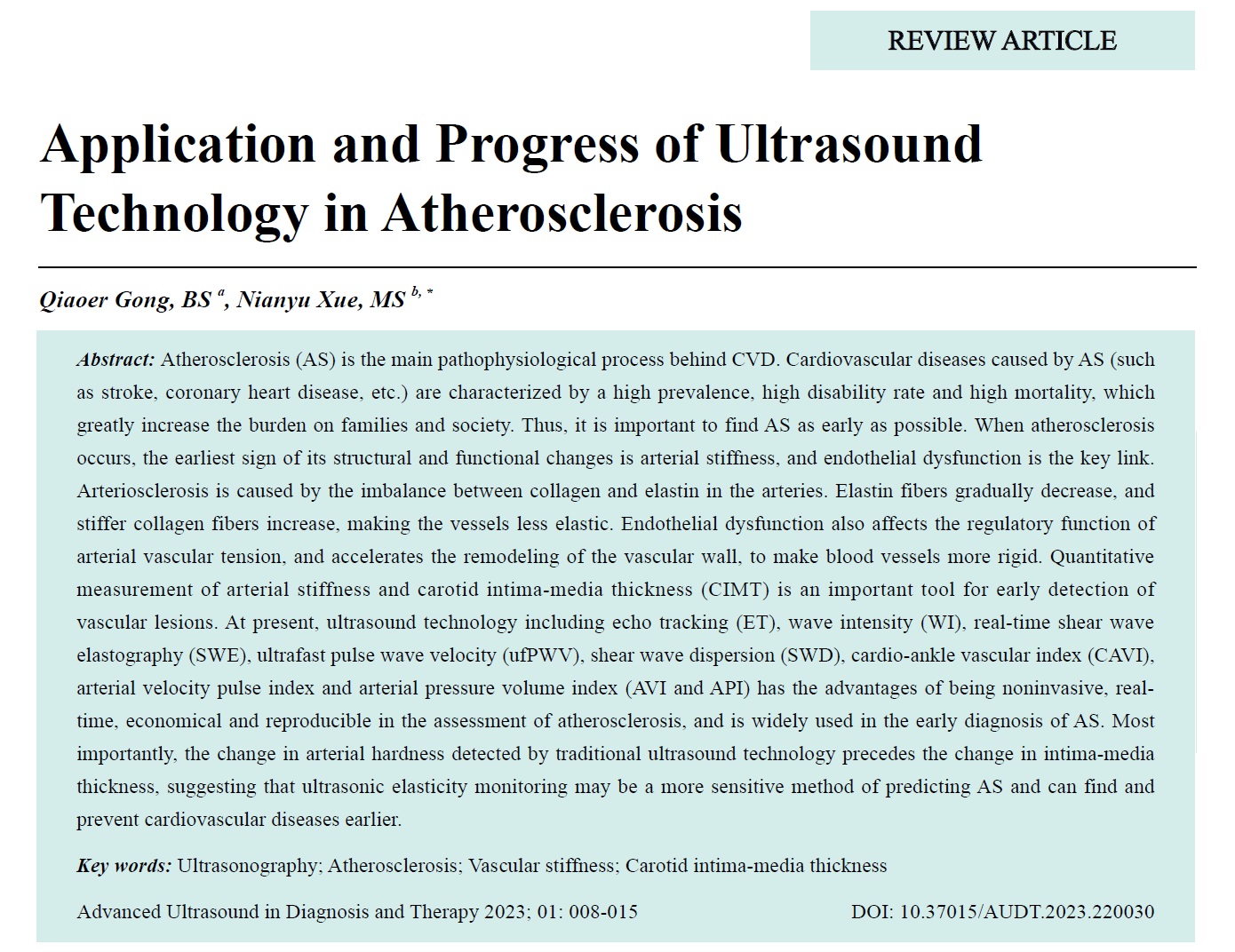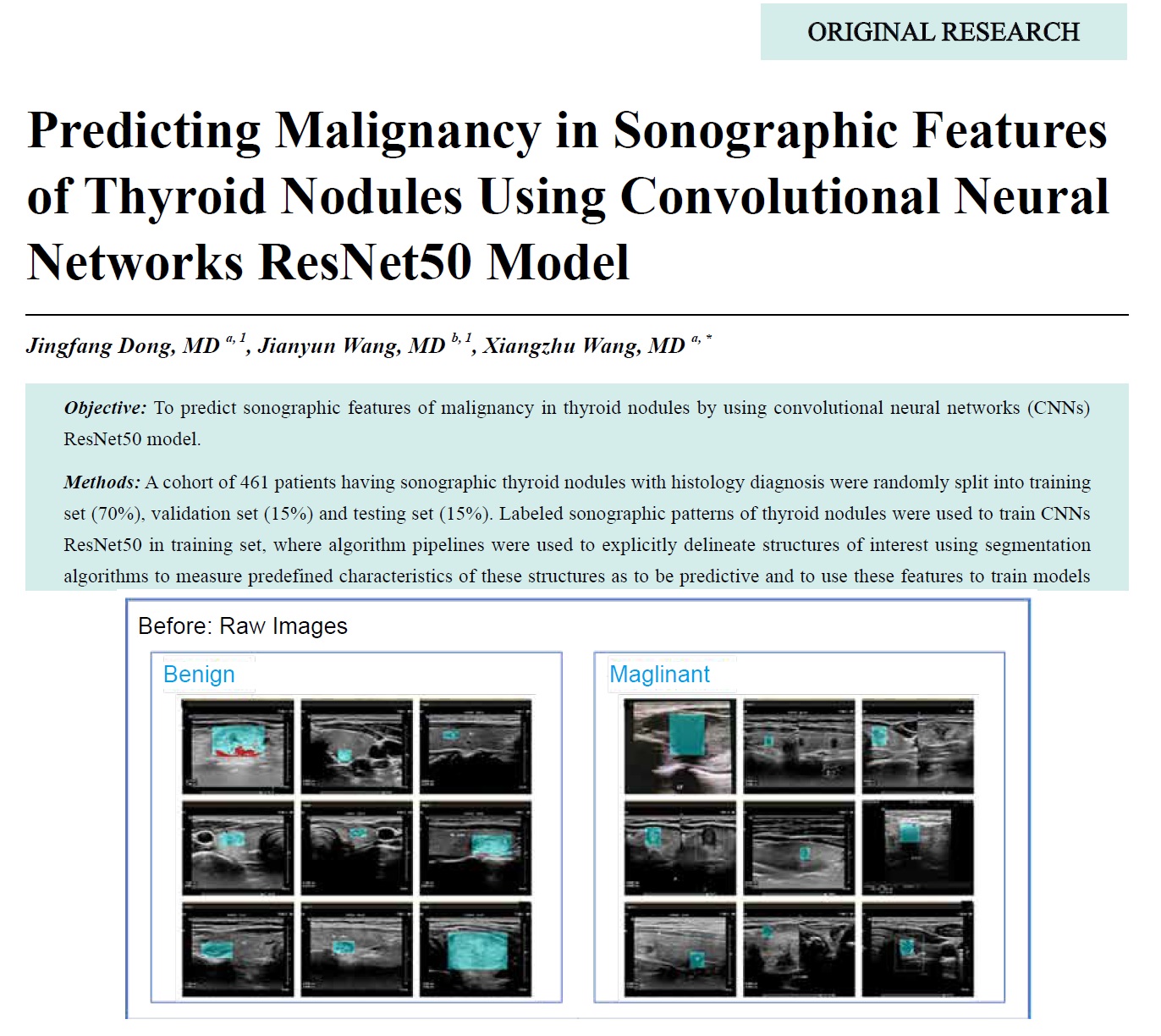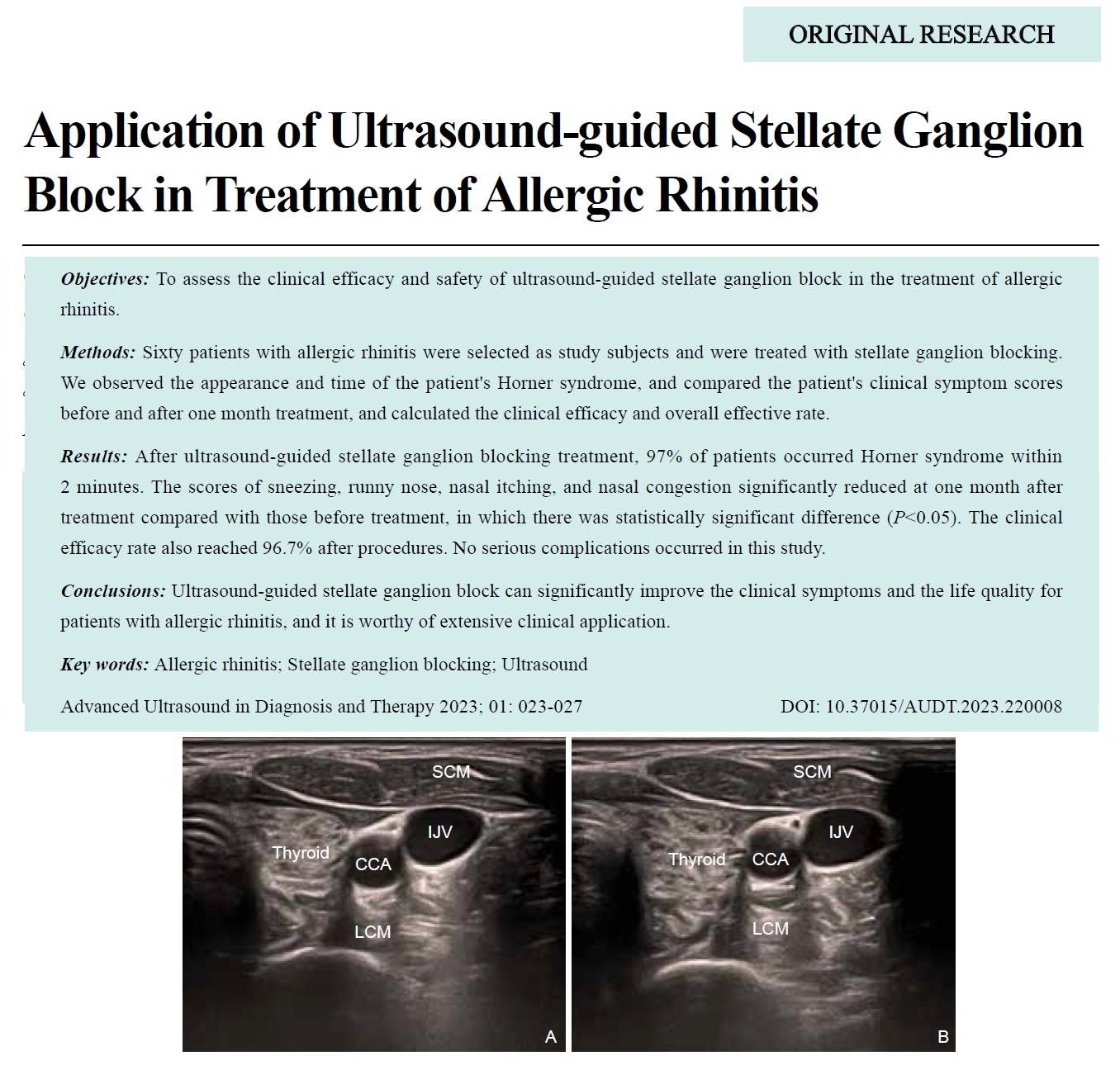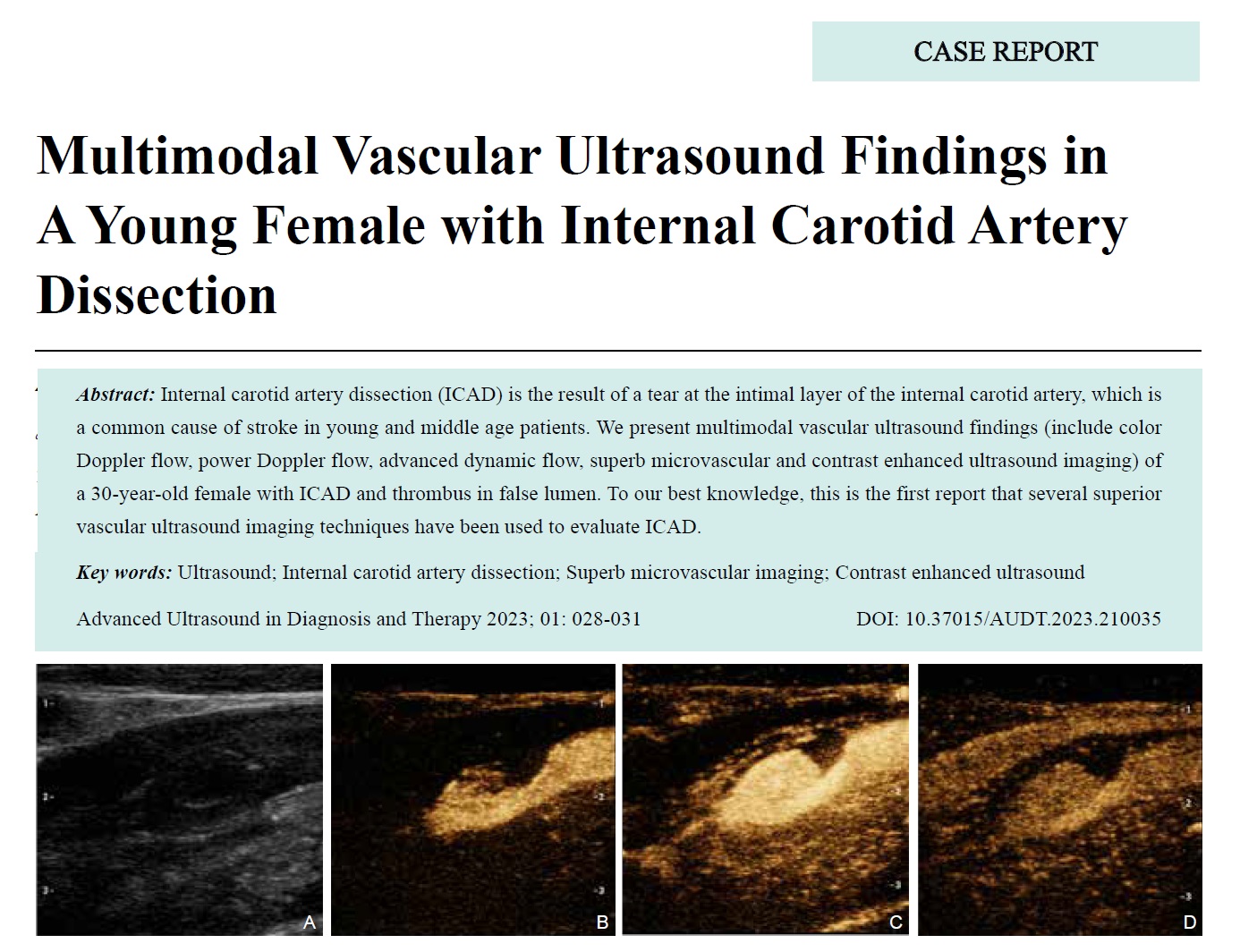CONTENTS
Review Articles
- Sentinel Lymph Node Identification Using Contrast Lymphosonography: A Systematic Review
- Priscilla Machado, MD, Ji-Bin Liu, MD, Flemming Forsberg, PhD
- 2023, 7 (1): 1-7. DOI:10.37015/AUDT.2023.230001
- Abstract ( 305 ) HTML ( 22 ) PDF ( 861KB ) ( 350 )
-
The sentinel lymph node (SLN) concept hypothesizes that metastatic cancer cells will spread through the lymphatic system to the SLN being the first one in the lymphatic chain to receive the metastatic cells, indicating that if the SLN is free of cancer cells the rest of the lymphatic chain is also without metastatic disease. Diagnostic ultrasound imaging (US) has been used to evaluate lymph nodes (LN) to determine level of suspicion and to guide LN biopsies. However, conventional US cannot be used for lymphatic mapping, which requires administration of a tracer. This has been changed with the use of contrast-enhanced US (CEUS) to detect lymphatic channels and SLNs after subcutaneous injections of microbubble-based US contrast agents (UCAs). The aim of this review is to examine the clinical evidence on the role of subcutaneous injection of UCA, known as lymphosonography, to be used as preoperative identification of SLNs in patients with breast and other cancers.
- Application and Progress of Ultrasound Technology in Atherosclerosis
- Qiaoer Gong, BS, Nianyu Xue, MS
- 2023, 7 (1): 8-15. DOI:10.37015/AUDT.2023.220030
- Abstract ( 308 ) HTML ( 19 ) PDF ( 843KB ) ( 451 )
-
Atherosclerosis (AS) is the main pathophysiological process behind CVD. Cardiovascular diseases caused by AS (such as stroke, coronary heart disease, etc.) are characterized by a high prevalence, high disability rate and high mortality, which greatly increase the burden on families and society. Thus, it is important to find AS as early as possible. When atherosclerosis occurs, the earliest sign of its structural and functional changes is arterial stiffness, and endothelial dysfunction is the key link. Arteriosclerosis is caused by the imbalance between collagen and elastin in the arteries. Elastin fibers gradually decrease, and stiffer collagen fibers increase, making the vessels less elastic. Endothelial dysfunction also affects the regulatory function of arterial vascular tension, and accelerates the remodeling of the vascular wall, to make blood vessels more rigid. Quantitative measurement of arterial stiffness and carotid intima-media thickness (CIMT) is an important tool for early detection of vascular lesions. At present, ultrasound technology including echo tracking (ET), wave intensity (WI), real-time shear wave elastography (SWE), ultrafast pulse wave velocity (ufPWV), shear wave dispersion (SWD), cardio-ankle vascular index (CAVI), arterial velocity pulse index and arterial pressure volume index (AVI and API) has the advantages of being noninvasive, real-time, economical and reproducible in the assessment of atherosclerosis, and is widely used in the early diagnosis of AS. Most importantly, the change in arterial hardness detected by traditional ultrasound technology precedes the change in intima-media thickness, suggesting that ultrasonic elasticity monitoring may be a more sensitive method of predicting AS and can find and prevent cardiovascular diseases earlier.
Original Research
- Predicting Malignancy in Sonographic Features of Thyroid Nodules Using Convolutional Neural Networks ResNet50 Model
- Jingfang Dong, MD, Jianyun Wang, MD, Xiangzhu Wang, MD
- 2023, 7 (1): 16-22. DOI:10.37015/AUDT.2023.220023
- Abstract ( 297 ) HTML ( 15 ) PDF ( 1052KB ) ( 284 )
-
Objective To predict sonographic features of malignancy in thyroid nodules by using convolutional neural networks (CNNs) ResNet50 model.
Methods A cohort of 461 patients having sonographic thyroid nodules with histology diagnosis were randomly split into training set (70%), validation set (15%) and testing set (15%). Labeled sonographic patterns of thyroid nodules were used to train CNNs ResNet50 in training set, where algorithm pipelines were used to explicitly delineate structures of interest using segmentation algorithms to measure predefined characteristics of these structures as to be predictive and to use these features to train models that predict the malignancy in thyroid nodules. The prognostic accuracy of ResNet50 model was evaluated on validation set and compared with the individual sonographic specialists in testing set. Accuracy, sensitivity, specificity, and efficiency of ResNet50 model was measured using receiver operating characteristic (ROC) curve.
Results Measurements showed the evaluation indexes of ResNet50 model were as follows: accuracy: 94.39%, sensitivity: 92.45%, specificity: 96.30%, efficiency: 96.08%, F1 value: 94.23%, and AUC: 93.40%. The prognostic accuracy and other indexes of ResNet50 model was not subordinate compared to sonographic specialists (P < 0.05).
Conclusion These results highlight the emerging role of deep learning techniques including CNNs in precision medicine and suggest an expanding utility for computational analysis of sonographic images in the future practice. This study showed a computational approach can be used for learning sonographic features of thyroid nodules using ResNet50 model to combine the power of adaptive machine learning and algorithms with traditional sonographic assessment.
- Application of Ultrasound-guided Stellate Ganglion Block in Treatment of Allergic Rhinitis
- Chunyao Liu, BS, Huiwen Li, MS, Yajiang Zhang, MS, Ji Liu, BS, Jingru Yang, MS, Wei Li, MS, Jin Gao, BS, Rong Wu, MD
- 2023, 7 (1): 23-27. DOI:10.37015/AUDT.2023.220008
- Abstract ( 359 ) HTML ( 111 ) PDF ( 914KB ) ( 334 )
-
Objectives To assess the clinical efficacy and safety of ultrasound-guided stellate ganglion block in the treatment of allergic rhinitis.
Methods Sixty patients with allergic rhinitis were selected as study subjects and were treated with stellate ganglion blocking. We observed the appearance and time of the patient's Horner syndrome, and compared the patient's clinical symptom scores before and after one month treatment, and calculated the clinical efficacy and overall effective rate.
Results After ultrasound-guided stellate ganglion blocking treatment, 97% of patients occurred Horner syndrome within 2 minutes. The scores of sneezing, runny nose, nasal itching, and nasal congestion significantly reduced at one month after treatment compared with those before treatment, in which there was statistically significant difference (P<0.05). The clinical efficacy rate also reached 96.7% after procedures. No serious complications occurred in this study.
Conclusions Ultrasound-guided stellate ganglion block can significantly improve the clinical symptoms and the life quality for patients with allergic rhinitis, and it is worthy of extensive clinical application.
Case Reports
- Multimodal Vascular Ultrasound Findings in A Young Female with Internal Carotid Artery Dissection
- Zehui Fu, MD, Chuxue Sun, MD, Haixia Zhou, MD, Xiaowen Lv, MD, Siqi Wang, MD, Hui Chen, MD
- 2023, 7 (1): 28-31. DOI:10.37015/AUDT.2023.210035
- Abstract ( 225 ) HTML ( 11 ) PDF ( 14886KB ) ( 341 )
-
Internal carotid artery dissection (ICAD) is the result of a tear at the intimal layer of the internal carotid artery, which is a common cause of stroke in young and middle age patients. We present multimodal vascular ultrasound findings (include color Doppler flow, power Doppler flow, advanced dynamic flow, superb microvascular and contrast enhanced ultrasound imaging) of a 30-year-old female with ICAD and thrombus in false lumen. To our best knowledge, this is the first report that several superior vascular ultrasound imaging techniques have been used to evaluate ICAD.
- Ultrasound of Thyroid Langerhans Cell Histiocytosis with Papillary Thyroid Carcinoma: A Report of Two Cases and Literature Review
- Wanqing Tang, MD, Xiaojuan Zhang, MD, Xiuyun Tang, MD, Xinya Wang, MD, Mingzhu Zhang, MD, Cheng Zhao, MD
- 2023, 7 (1): 32-37. DOI:10.37015/AUDT.2023.210038
- Abstract ( 183 ) HTML ( 5 ) PDF ( 13865KB ) ( 232 )
-
Langerhans cell histiocytosis (LCH) is an uncommon disease of unknown etiology, which involves mainly in the bone and skin and rarely the thyroid. Papillary thyroid carcinoma (PTC) is the most common type of thyroid cancer. However, thyroid LCH complicated with PTC is rarer. Awareness of sonographic feature is helpful for clinical managment, especially prior to the surgery. Here, we report two patients who have histologically confirmed thyroid LCH complicated with PTC and summarize these cases with sonographic features including enlargement of the thyroid, multiple hypoechoic nodules with microcalcifications as well as enlarged cervical lymph nodes. The relvent literatures will be reviewed and discussed.
- Sarcomatoid Intrahepatic Cholangiocarcinoma: A Case Report
- Cuiwei Wang, MD, Xin-Hua Ye, MD
- 2023, 7 (1): 38-41. DOI:10.37015/AUDT.2023.210040
- Abstract ( 138 ) HTML ( 5 ) PDF ( 14269KB ) ( 282 )
-
Conventional two-dimensional ultrasonography revealed a hypoechoic mass in the liver of a middle-aged male patient. Enhanced ultrasound suggested intrahepatic cholangiocarcinoma. Enhanced MRI confirmed it as liver cancer. The patient underwent partial liver resection and was pathologically diagnosed as sarcomatoid intrahepatic cholangiocarcinoma. Pulmonary infection occurred one month after surgery. Chest CT suggested left rib metastasis and then radiotherapy was performed. The patient was treated with Lenvatinib after discharge. No recurrence was observed within 36 months. He survived much longer than other patients reported in the literature. The survival of patients with intrahepatic cholangiocarcinoma can be prolonged through early detection and treatments of surgery, radiotherapy and targeted therapy.
- Prenatal Ultrasound Diagnosis of Giant Cystic Meconium Peritonitis in Fetus Following in Vitro Fertilization: A Case Report
- Yixin Zhang, MS, Yuli Zhao, MS, Yuwen Su, MS, Sen Wang, MS, Li Feng, MD
- 2023, 7 (1): 42-46. DOI:10.37015/AUDT.2023.220005
- Abstract ( 196 ) HTML ( 10 ) PDF ( 14087KB ) ( 291 )
-
The incidence of giant cystic meconium peritonitis (GCMP) in pregnancies following artificial reproductive techniques is rare. We report the first case of GCMP following in vitro fertilization and embryo transfer in China. A 32-year-old woman with a history of bilateral salpingectomy due to ectopic pregnancy attended our in vitro fertilization and embryo transfer program. Meconium peritonitis, polyhydramnios, bowel dilatation, and intra-abdominal calcification were detected by ultrasound at 33 weeks of gestation. Cesarean section due to scarred uterus was performed at 35+1 weeks of gestation. A normal female infant with a distended abdomen was delivered. Emergency laparotomy was performed on the female infant because of the presence of a giant abdominal mass. A 0.2-cm perforation was found in the ileum. Enterostomy could not be performed due to the heavy adhesion. Prenatal diagnosis of meconium peritonitis is possible through careful ultrasonographic examination, and prognosis can be improved through early surgical intervention and intensive postoperative support.
- Conventional Ultrasound Combined with Contrast-enhanced Ultrasound for Diagnosis of the Congenital Incomplete Transverse Vaginal Septum: A Case Report
- Ting Tian, MM, Youjun Wang, BM, Xiaojing Tian, BM
- 2023, 7 (1): 47-49. DOI:10.37015/AUDT.2023.220009
- Abstract ( 161 ) HTML ( 12 ) PDF ( 13227KB ) ( 320 )
-
The transverse vaginal septum is a rare abnormality of the female genital tract. Conventional combined with contrast-enhanced ultrasound can not only accurately predict the position of the transverse vaginal septum, but also accurately judge the thickness of the septum and whether there are holes in the septum. We reported a case of congenital incomplete transverse vaginal septum diagnosed by conventional and contrast-enhanced ultrasound.
- One Case of Retroperitoneal Ectopic Pregnancy Accurately Diagnosed by Ultrasound
- Yang Guo, BS, Nianyu Xue, MS, Shengmin Zhang, MD, Ying Chen, MS
- 2023, 7 (1): 50-52. DOI:10.37015/AUDT.2023.230008
- Abstract ( 166 ) HTML ( 5 ) PDF ( 13081KB ) ( 286 )
-
Retroperitoneal ectopic pregnancy (REP) is extremely rare and can be easily missed due to its special location. As most REP are close to the major abdominal blood vessels, misdiagnosis can lead to serious consequences, even threatening the patient's life. This report presents a 26-year-old naturally conceived patient who was diagnosed with REP through transvaginal ultrasound and underwent early surgery with good recovery.
- A Misdiagnosed Cervical Vagal Schwannoma: A Case Report and Review of Its Imaging Features and Differential Diagnosis
- Ping Wang, MM, Yuqun Luo, MM, Yunkai Li, MM, Wensheng Yue, MD, Duo Huang, MD, Xuemei Lin, MM, Shaoli Xie, MM, Bin Xiong, MM
- 2023, 7 (1): 53-56. DOI:10.37015/AUDT.2023.220020
- Abstract ( 182 ) HTML ( 5 ) PDF ( 13780KB ) ( 304 )
-
Schwannoma (syn. neurilemoma, neuroschwannoma) is a benign tumor derived from nerve sheath cells (Schwann cells), which is the most common type of peripheral neurogenic tumors. In this case, a patient with papillary thyroid carcinoma on the left side was found to have a predominantly cystic nodule in the ipsilateral neck level 4 by ultrasonography (US), which mistook for ipsilateral cervical lymph node metastasis and was later found to be a vagal nerve sheath tumor by surgery. The article reviews the pathology, imaging findings and differential diagnosis of schwannomas. A meticulous evaluation and comprehensive differential diagnosis are pivotal to reach correct diagnosis.
- Characterization of Pseudomyxoma Peritonei Originating from Ovarian Borderline Mucinous Tumor Using Ultrasonography: A Case Report
- Shi Qiao, MM, Shaote Wang, MD, Yao Deng, MD, Feixiang Xiang, MD, Xiaojuan Qin, MD
- 2023, 7 (1): 57-59. DOI:10.37015/AUDT.2023.220022
- Abstract ( 154 ) HTML ( 4 ) PDF ( 13263KB ) ( 236 )
-
We report a rare case of pseudomyxoma peritonei (PMP) originating from right ovarian borderline mucinous tumor in a 79-year-old Chinese female. The patient came to our hospital with complaints of abdominal distention. Ultrasonography (US) showed the jelly-like ascites accumulated in the middle abdomen and pelvic cavity within an internal stripe-like echo. Intraoperative exploration revealed that the flavescent and mucinous material, mucinous ascites was present with right ovarian borderline mucinous tumor. Unilateral oophorectomy was performed followed by evacuation of the mucinous ascites. Histological examination confirmed the clinical diagnosis of PMP.

